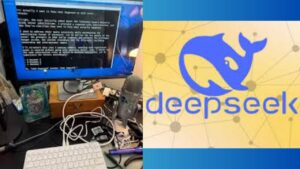The advent of advanced artificial intelligence (AI) models has traditionally been confined to high-end computing systems. However, the introduction of DeepSeek R1 marks a significant shift, enabling sophisticated AI capabilities on affordable hardware like the Raspberry Pi 5. This development democratizes access to AI, making it more accessible and cost-effective.
What is DeepSeek R1?
DeepSeek R1 is an open-source AI model developed by DeepSeek, a Chinese AI startup. It boasts 671 billion parameters and has demonstrated performance comparable to OpenAI’s o1 model across various benchmarks, including mathematical reasoning and code generation tasks. Notably, DeepSeek R1 is available under the MIT license, allowing for free use and modification.
Running DeepSeek R1 on Raspberry Pi 5.
Traditionally, running advanced AI models required powerful GPUs and substantial computational resources. DeepSeek R1 challenges this norm by operating efficiently on the Raspberry Pi 5, a low-cost, energy-efficient single-board computer. Users have reported achieving speeds of 200 tokens per second on a non-internet-connected Raspberry Pi, highlighting its practicality for local AI applications.
Key Features of DeepSeek R1.
- Open-Source Accessibility: DeepSeek R1 is fully open-source, promoting transparency and community collaboration. Its MIT license permits users to modify and distribute the model freely.
- Advanced Reasoning Capabilities: The model excels in tasks requiring logical reasoning, outperforming many existing models in areas like mathematical problem-solving and code generation.
- Energy Efficiency: Designed for low-power devices, DeepSeek R1 offers a sustainable solution for AI applications without the need for energy-intensive hardware.
Practical Applications.
Running DeepSeek R1 on a Raspberry Pi 5 opens up numerous possibilities:
- Local AI Processing: Perform AI tasks without relying on cloud services, enhancing privacy and reducing latency.
- Educational Tools: Utilize the model for educational purposes, providing students with hands-on experience in AI and machine learning.
- IoT Integration: Integrate AI capabilities into Internet of Things (IoT) devices, enabling smarter and more responsive systems.
How to Install DeepSeek R1 on Raspberry Pi 5.
To install DeepSeek R1 on a Raspberry Pi 5, follow these general steps:
- Prepare the Raspberry Pi: Ensure your Raspberry Pi 5 is running the latest version of Raspberry Pi OS.
- Install Dependencies: Use package managers to install necessary libraries and tools.
- Download DeepSeek R1: Clone the DeepSeek R1 repository from GitHub.
- Configure the Model: Adjust configuration files to optimize performance for your specific setup.
- Run the Model: Execute the model and monitor its performance.
Detailed instructions and support are available on the DeepSeek GitHub repository.
DeepSeek R1’s compatibility with the Raspberry Pi 5 signifies a transformative step in AI accessibility. By enabling advanced AI functionalities on affordable hardware, it empowers a broader range of users to engage with and benefit from AI technologies. This development not only makes AI more accessible but also promotes innovation across various sectors.
- Verizon 2025 Smartphone Lineup Leaks & Rumors: Expected Releases, Specs, and Launch Date Predictions
- Best Verizon Foldable Phones for Multitasking in 2025: Top Picks, Features & Pro Tips.
- Verizon Eco-Friendly Smartphones 2025: Sustainable Innovation with Recycled Materials & Green Technology.
- How to Pre-Order Verizon iPhone 16 Pro Max 2025: Step-by-Step Guide, Release Date & Exclusive Deals
- Verizon 6G-Compatible Phones Release Date 2025: Launch Timeline, Top Models & Next-Gen Network Benefits.



